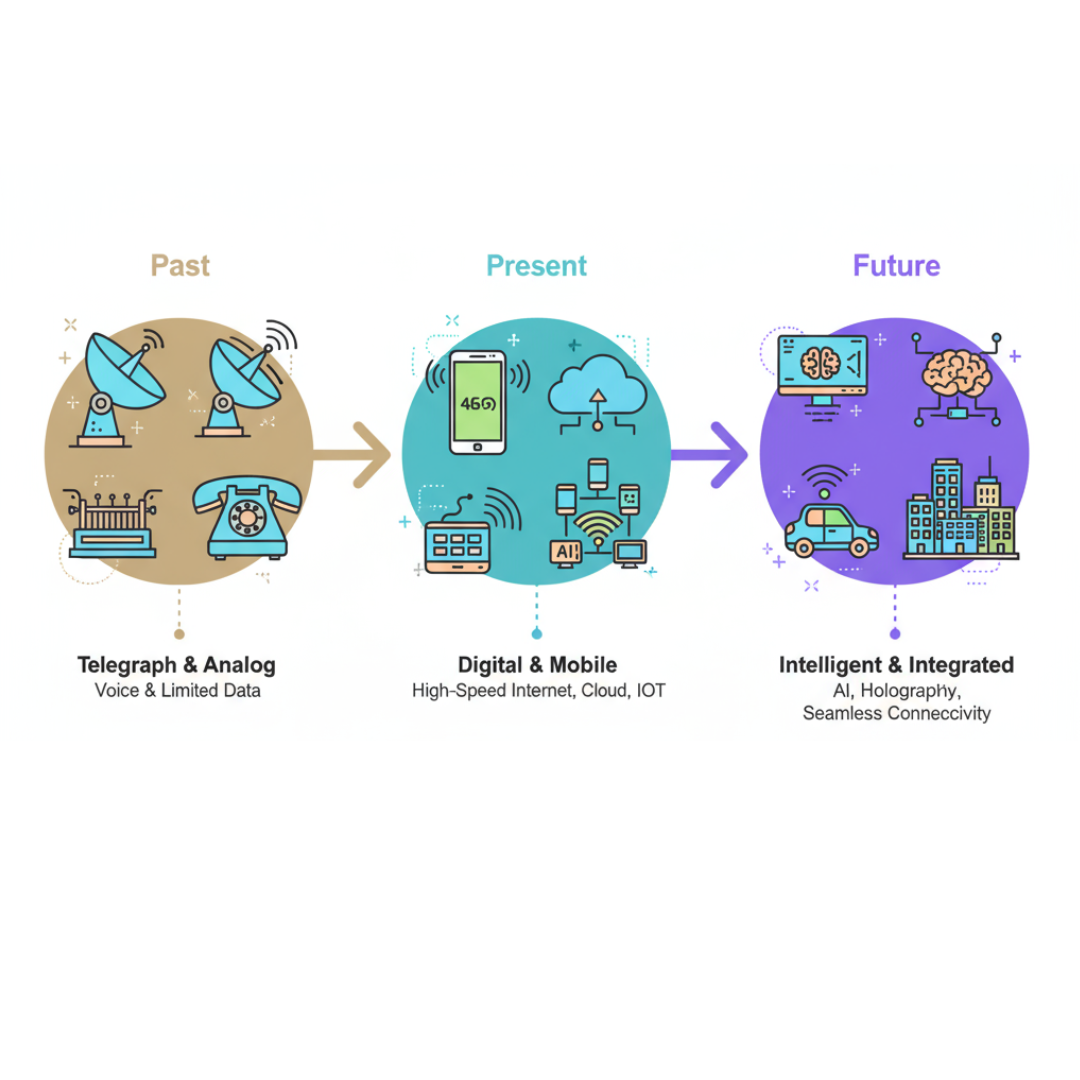The Evolution of Telecommunications: Past, Present, and Future
The telecommunications industry has undergone one of the most dramatic transformations in human history. From the first telegraph messages to today's lightning-fast 5G networks, the way we communicate has evolved at an unprecedented pace. Understanding this evolution isn't just about appreciating technological progress—it's about recognizing the patterns that will shape our connected future.

The Foundation Years: From Telegraph to Telephone
The story begins in 1844 when Samuel Morse sent the first telegraph message: "What hath God wrought." This simple transmission between Washington D.C. and Baltimore marked the birth of long-distance electrical communication. The telegraph network expanded rapidly, connecting continents and revolutionizing commerce, journalism, and personal communication.
Alexander Graham Bell's telephone invention in 1876 took communication a step further. Unlike the telegraph's dots and dashes, the telephone transmitted actual voices, making communication more personal and intuitive. By 1915, the first transcontinental telephone call connected New York and San Francisco, proving that voice could travel across vast distances.
The early 20th century saw the rise of radio communication, enabling wireless transmission of voice and data. This breakthrough laid the groundwork for mobile communication technologies that would emerge decades later.
The Digital Revolution: Transforming Communication
The 1960s and 70s marked the beginning of the digital age in telecommunications. The development of packet switching technology allowed data to be broken into small packets and transmitted across networks more efficiently. This innovation became the foundation of the internet as we know it today.
The launch of the first commercial cellular network in 1983 revolutionized personal communication. Suddenly, phones weren't tethered to walls—they could travel with us. The introduction of digital cellular networks in the 1990s improved call quality and enabled text messaging, creating new forms of instant communication.
The internet's widespread adoption in the 1990s transformed telecommunications from primarily voice-based to data-centric. Email, websites, and early forms of instant messaging began to compete with traditional phone calls for people's attention and communication needs.
Present Day: The Age of Convergence
Today's telecommunications landscape is defined by convergence—the merging of voice, data, video, and mobile services into unified platforms. Modern businesses no longer think in terms of separate phone systems, internet connections, and video conferencing solutions. Instead, they expect integrated communication ecosystems that work seamlessly across devices and locations.
- Cloud-First Architecture: Traditional on-premise phone systems are giving way to cloud-based solutions that offer greater flexibility, scalability, and cost-effectiveness.
- Unified Communications: Modern platforms integrate voice calls, video conferencing, instant messaging, file sharing, and collaboration tools into single interfaces.
- Mobile Integration: The line between mobile and fixed communication has blurred, with employees expecting to access all communication tools from their smartphones and tablets.
- AI Enhancement: Artificial intelligence is being integrated into communication systems for features like intelligent call routing, real-time transcription, and predictive analytics.
- 5G Deployment: The rollout of 5G networks is enabling new applications with ultra-low latency and massive device connectivity.
The Future: Emerging Trends and Technologies
Looking ahead, several trends will shape the next phase of telecommunications evolution:
- Artificial Intelligence and Automation: AI will become increasingly central to telecommunications infrastructure, optimizing call routing, predictive analytics, and network management.
- Internet of Things (IoT) Integration: The explosive growth of connected devices will require networks to handle billions of simultaneous connections.
- Augmented and Virtual Reality: AR and VR technologies will demand high-definition, low-latency video streaming for entertainment and business applications.
- Edge Computing: More processing power will move closer to end users to reduce latency and improve performance.
- Quantum Communication: Promises ultra-secure data transmission, with early implementations in high-security applications.
- Satellite Internet Constellations: LEO satellite networks like Starlink aim to provide high-speed internet access globally, democratizing telecommunications services.
Implications for Businesses
- Embrace Cloud Solutions: Cloud-based telecommunications offer better scalability and lower costs than traditional on-premise systems.
- Plan for Integration: Choose solutions that integrate with existing business tools and workflows.
- Consider Mobile-First: Mobile-friendly communication tools are essential for remote work environments.
- Invest in Security: Robust security measures are critical as communication becomes more digital and distributed.
- Prepare for Change: Build flexibility into infrastructure to adapt to emerging technologies.
Conclusion
The evolution of telecommunications has been a story of increasing speed, decreasing distance, and expanding possibilities. From the first telegraph to today's global internet, each advancement has opened new opportunities for human connection and business innovation.
As we look toward the future, one thing remains certain: the pace of change will continue to accelerate. Organizations that understand these trends and adapt accordingly will be best positioned to leverage new communication technologies for competitive advantage. The key is not just keeping up with change, but anticipating it and building systems that can evolve along with the technology.
The next chapter in telecommunications history is being written today through 5G deployments, AI integration, and emerging technologies we're only beginning to understand. By staying informed about these developments, businesses can make strategic decisions that will serve them well in an increasingly connected world.